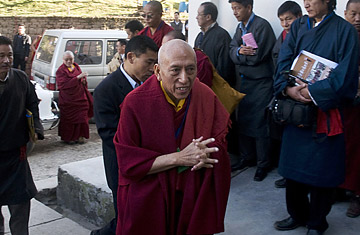
Samdhong Rinpoche, the Prime Minister of the self-proclaimed Tibetan government-in-exile, arrives at the Tibetan Children's Village School in Dhamsala, India, Monday, Nov. 17, 2008
A historic summit of Tibetan exiles in the north Indian hill-station town of Dharamsala ended its third full day on a note of optimism that their experiment in democracy might actually succeed.
About 550 Tibetan political leaders and activists have come from as far away as Canada, Australia and Brussels to discuss the future of the Tibetan movement. Its spiritual leader, the Dalai Lama, has long advocated a democratic decision-making process, but Tibetans' reverence for him has inhibited many of them from speaking out in any way that might challenge his authority. "This is the problem with having God as your leader," says Tsering Shakya, a professor of modern Tibetan history at the University of British Columbia. A referendum in the early 1990s on whether to give the Dalai Lama a mandate to follow his "Middle Path," seeking autonomy within China, resulted in such overwhelming support that some Tibetans doubted that it was a true expression of democracy. "People were upset by that," says Robbie Barnett, a professor of Tibetan studies at Columbia University. (See pictures of the Dalai Lama at home in Dharamsala.)
This week's summit is a test of whether Tibetans are ready to step out from under His Holiness's shadow. The Dalai Lama is not attending any of the talks, nor has he appointed anyone in the Tibetan parliament-in-exile's leadership to direct them. Instead, all the summit delegates — regional Tibetan community representatives, members of parliament, youth leaders, independence activists and other NGOs — were divided into about 15 groups by choosing numbers at random on the first day of the talks. They have split up in the various government buildings scattered around Macleodganj, where the Dalai Lama makes his home, and will gather on Friday at the Tibetan Children's Village School, where each subgroup will present a report to the summit as a whole. The parliament will later compile those reports and present a set of recommendations.
The process may sound as worthy and bureaucratic as a conclave of some obscure United Nations agency. But as with any gathering of this size, the real action is happening informally, in the courtyards and coffee houses around Dharamsala. Old friends and classmates are seeing each other after many years, comparing notes on their children and counting gray hairs. The radicals of the movement, who advocate a free Tibet, are buttonholing the centrists to shore up support in the mainstream. And everyone in Dharamsala is getting a chance to catch a glimpse of Tibet's aristocracy. (Was that the Dalai Lama's sister driving by?)
The atmosphere is part family reunion, part political convention. And for the first time, this group of exiles is connecting in an organized way with Tibetans inside Tibet. The parliament, working through unspecified means, compiled 17,000 individual suggestions for the delegates from people inside Tibet. About 8,000 of them simply stated support for whatever the Dalai Lama decides, but 5,000 were in favor of independence. There was also a public film screening Thursday evening of secretly recorded interviews with 108 Tibetans from inside Tibet. Those views could have a significant influence on the direction of the movement. As one independence activist told me, "How can 100,000 Tibetans decide the fate of 5 million?" Resolving that paradox will be the next test of Tibet's unique brand of distributed democracy.
See pictures from the Dalai Lama's six decades leading Tibet here.
